Experimental Investigation of the Size Effect on Roller-Compacted Hydraulic Asphalt Concrete under Different Strain Rates of Loading
Abstract
Highlights
- (1)
- Failure modes of RCHAC under the coupling effect of the strain rate effect and the size effect were analyzed.
- (2)
- Dynamic mechanical properties under different size and strain rates were presented.
- (3)
- The effect of strain energy on failure modes was analyzed.
- (4)
- A modified dynamic size effect law was proposed.
Abstract
1. Introduction
2. Materials and Methods
2.1. Specimen Preparation
2.2. Experimental Methods
3. Results and Analysis
3.1. Compressive Strength
3.2. Elastic Modulus
3.3. Failure Modes
3.4. Strain Energy Analysis of Failure Modes
4. The Dynamic Size Effect Theory
4.1. The Size Effect on Mechanical Properties
4.2. The Strain Rate Effect
4.3. The Dynamic Size Effect Model
5. Conclusions
- (1)
- The strain rate and specimen size have coupling effects on the failure modes of RCHAC. When the strain rate is larger or the size is smaller, the damage degree becomes greater. When the strain rate is 10−3 s−1, the specimen with a height-to-diameter ratio of 0.5 shows shear failure. When the strain rate decreases or the size increases, the failure modes of the specimen changes gradually from shear failure to aggregate fracture and bond failure. When the strain rate is 10−3 s−1, the specimen with a height-to-diameter ratio of two has no obvious cracks, and only part of the asphalt matrix is extruded.
- (2)
- When the ambient temperature is 5 °C, there is an obvious size effect on the mechanical properties of RCHAC when the specimen height ranges from 50 mm to 200 mm. When the specimen size increases, the compressive strength decreases non-linearly, and this decreasing trend gradually declines, while the elastic modulus increases non-linearly, and the increasing trend decreases gradually.
- (3)
- The strain rate has an effect on the size effect of the mechanical properties of RCHAC. With the increase in strain rate, the variation trend of compressive strength and the elastic modulus with size is more significant.
- (4)
- A dynamic size effect model considering strain rate enhancement is proposed, and the relationship between the dynamic loading rate, size, compressive strength, and elastic modulus is established, which can reasonably describe the size effect of dynamic compressive performance under strain rate effect.
- (5)
- The proposed dynamic size effect model considering strain rate enhancement established the relationship between the dynamic loading rate, size, compressive strength, and elastic modulus, and it could reasonably describe the size effect of dynamic compressive performance under strain rates from 10−5 s−1 to 10−2 s−1.
Author Contributions
Funding
Institutional Review Board Statement
Informed Consent Statement
Data Availability Statement
Conflicts of Interest
Nomenclature
| Symbol | Paraphrase |
| U | Total input strain energy |
| Ud | Dissipative strain energy |
| Ue | Elastic strain energy |
| εp | Peak strain |
| σp | Compressive strength |
| εe | Elastic strain |
| D | Diameter of the specimen |
| t | Strength of the specimen with a height of 100 mm |
| γ | The ratio of height to diameter |
| Fc | The mechanical parameter |
| Pd | Dynamic mechanical parameters |
| Ps | Quasi-static mechanical parameters |
| Dynamic strain rate | |
| Quasi-static strain rate | |
| D0, βc, γc, and α | The fitting parameters |
References
- Wang, W.; Höeg, K. The Asphalt Core Embankment Dam: A Very Competitive Alternative; Modern Rockfill Dams: Beijing, China, 2009. [Google Scholar]
- Hao, J.; Liu, Z.; Wang, Z. Development and prospect of hydropower project with asphalt concrete impervious elements in China. J. Hydraul. Eng. 2018, 49, 1137–1147. [Google Scholar]
- Han, X.; Hu, Z.; Yu, L.; Pang, Y.; She, H.; Zhang, L.; Wang, X.; Qi, C. Dynamic Characteristics of Asphalt Concrete as an Impervious Core in Embankment Dams under Varying Temperatures and Stress States. Materials 2023, 16, 6529. [Google Scholar] [CrossRef] [PubMed]
- Baziar, M.; Salemi, S.; Heidari, T. Analysis of earthquake response of an asphalt concrete core embankment dam. Int. J. Civ. Eng. 2006, 4, 192–210. [Google Scholar]
- Wang, W.; Hu, K.; Feng, S.; Li, G.; Höeg, K. Shear behavior of hydraulic asphalt concrete at different temperatures and strain rates. Constr. Build. Mater. 2020, 230, 117022. [Google Scholar] [CrossRef]
- Wang, W.; Höeg, K. Cyclic behavior of asphalt concrete used as impervious core in embankment dam. J. Geotech. Environ. Eng. ASCE 2011, 137, 536–544. [Google Scholar] [CrossRef]
- Bažant, Z.P. Size Effect in Blunt Fracture: Concrete, Rock, Metal. J. Eng. Mech. 1984, 110, 518–535. [Google Scholar] [CrossRef]
- Bažant, Z.; Planas, J. Fracture and Size Effect in Concreteand Other Quasibrittle Materials; CRC Press: Boca Raton, FL, USA, 1998; pp. 7–15. [Google Scholar]
- Du, X.; Jin, L.; Li, D. A state-of-the-art review on the size effect of concretes and concrete structures (Ⅰ): Concrete materials. China Civ. Eng. J. 2017, 50, 28–45. [Google Scholar]
- Chowdari, S.G.; David, A.; Benjamin, F.B. Specimen size effect on dynamic modulus measurement of Cold recycled and full depth reclamation mixtures. Constr. Build. Mater. 2023, 393, 132095. [Google Scholar]
- Hu, J.; Wu, X.; Hu, S. Dynamic mechanical behavior of EPS concrete. J. Vib. Shock 2011, 30, 205–209. [Google Scholar]
- Wang, W.; Bai, Z.; Jiang, F. The Researches of engineering behaviors of asphalt concrete. Pet. Asph. 1997, 4, 21–25. [Google Scholar]
- Kim, H.; Wagoner, M.P.; Buttlar, W.G. Numerical fracture analysis on the specimen size dependency of asphalt concrete using a cohesive softening model. Constr. Build. Mater. 2009, 23, 2112–2120. [Google Scholar] [CrossRef]
- Liu, Y.; You, Z.; Zhao, Y. Three-dimensional discrete element modeling of asphalt concrete: Size effects of elements. Constr. Build. Mater. 2012, 37, 775–782. [Google Scholar] [CrossRef]
- Haghighat, P.J.; Aliha, M.R.; Keymanesh, M.R. Evaluating mode I fracture resistance in asphalt mixtures using edge notched disc bend ENDB specimen with different geometrical and environmental conditions. Eng. Fract. Mech. 2018, 190, 245–258. [Google Scholar] [CrossRef]
- Akhtarpour, A.; Khodaii, A. Experimental study of asphaltic concrete dynamic properties as an impervious core in embankment dams. Constr. Build. Mater. 2013, 41, 319–334. [Google Scholar] [CrossRef]
- Nakamura, Y. Improvement of impervious asphalt mixture for high ductility against earthquake excitation. In Proceedings of the 4th International Conference Dam Engineering, Nanjing, China, 18–20 October; pp. 647–656.
- Ning, Z.; Liu, Y.; Xue, X. Dynamic compressive behaviors of hydraulic asphalt concrete under different temperatures. J. Hydroelectr. Eng. 2019, 38, 24–34. [Google Scholar]
- Chen, Y.; Jiang, T.; Huang, Z.; Fu, W. Effect of temperature on mechanical properties of asphalt concrete. Rock Soil Mech. 2010, 31, 92–96. [Google Scholar]
- Albayati, A.H.; Ajool, Y.S.; Allawi, A.A. Comparative Analysis of Reinforced Asphalt Concrete Overlays: Effects of Thickness and Temperature. Materials 2023, 16, 5990. [Google Scholar] [CrossRef]
- Krauthammer, T.; Elfahal, M.; Lim, J.; Ohno, T.; Beppu, M.; Markeset, G. Size effect for high-strength concrete cylinders subjected to axial impact. Int. J. Impact Eng. 2003, 28, 1001–1016. [Google Scholar] [CrossRef]
- Elfahal, M.; Krauthammer, T.; Ohno, T.; Beppu, M.; Mindess, S. Size effect for normal strength concrete cylinders subjected to axial impact. Int. J. Impact Eng. 2005, 31, 461–481. [Google Scholar] [CrossRef]
- Liang, C.; Li, X.; Zhang, H.; Li, S. Reserch on size effect of uniaxial compression properties of granite under medium and low strain rates. Chin. J. Rock Mech. Eng. 2013, 32, 528–536. [Google Scholar]
- Jin, L.; Yu, W.; DU, X.; Zhang, S.; Li, D. Meso-scale modelling of the size effect on dynamic compressive failure of concrete under different strain rates. Int. J. Impact Eng. 2019, 125, 1–12. [Google Scholar] [CrossRef]
- DL/T 5362-2006; Test Code for Hydraulic Bitumen Concrete. National Development and Reform Commission of the People’s Republic of China: Beijing, China, 2018.
- Du, X.; Wang, Y.; Lu, D. Nonlinear multiaxial dynamic strength criterion for concrete material. J. Hydraul. Eng. 2010, 41, 300–309. [Google Scholar]
- Tekalur, S.A.; Shukla, A.; Sadd, M.; Lee, K.W. Mechanical characterization of a bituminous mix under quasi-static and high-strain rate loading. Constr. Build. Mater. 2009, 23, 1795–1802. [Google Scholar] [CrossRef]
- Baldassari, M.; Monaco, A.; Sapora, A.; Cornetti, P. Size effect on flexural strength of notched and un-notched concrete and rock specimens by Finite Fracture Mechanics. Theor. Appl. Fract. Mech. 2023, 125, 103787. [Google Scholar] [CrossRef]
- Milad, S.; Javad, A.; Ali, R.Z. Assessment of mode I fracture of rock-type sharp V-notched samples considering the size effect. Theor. Appl. Fract. Mech. 2021, 116, 103136. [Google Scholar]
- Ning, Z.; Liu, Y.; Wang, Q.; Wang, W. Experimental study on the dynamic compressive behavior of asphalt concrete under different temperature. J. Vib. Shock 2021, 40, 243–250. [Google Scholar]
- Wang, Q.; Li, Q.; Yin, X.; Xu, S. Structural size effect in the mode I and mixed mode I/II fracture of strain-hardening cementitious composites (SHCC). Int. J. Solids Struct. 2023, 288, 112628. [Google Scholar] [CrossRef]
- Xie, H.; Ju, Y.; Li, L. Criteria for strength and structural failure of rocks based on energy dissipation and energy release principles. Chin. J. Rock Mech. Eng. 2005, 17, 3003–3010. [Google Scholar]
- Jin, L.; Li, J.; Yu, W.; Du, X. Size effect modelling for dynamic biaxial compressive strength of concrete: Influence of lateral stress ratio and strain rate. Int. J. Impact Eng. 2021, 156, 103942. [Google Scholar] [CrossRef]
- Yu, W.; Liu, J.; Du, X. Experimental investigation on splitting-tension failures of basalt fiber-reinforced lightweight aggregate concrete: Effects of strain rate and structure size. J. Build. Eng. 2023, 68, 105853. [Google Scholar] [CrossRef]
- Xie, H.; Ju, Y.; Li, L.; Peng, R.D. Energy mechanism of formation and failure of rock masses. Chin. J. Rock Mech. Eng. 2008, 9, 6–17. [Google Scholar]
- Weibull, W. The phenomenon of rupture in solids. Proc. R. Swed. Inst. Eng. Res. 1939, 153, 1–55. [Google Scholar]
- Carpinteri, A.; Ferro, G. Size effects on tensile fractureproperties: A unified explanation based on disorder andfractality of concrete microstructure. Mater. Struct. 1994, 27, 563–571. [Google Scholar] [CrossRef]
- Yan, D.; Li, H.; Liu, J.; Zheng, H. Dynamic properties of concrete specimens with different size. J. Hydraul. Eng. 2014, 45 (Suppl. 1), 95–99. [Google Scholar]
- Comite Euro-International Du Beton. CEB-FIP Model Code 1990; Redwood Books: Trowbridge, UK, 1993. [Google Scholar]
- Ning, Z.; Liu, Y.; Wang, W. Compressive Behavior of Hydraulic Asphalt Concrete under Different Temperatures and Strain Rates. J. Mater. Civ. Eng. 2021, 33. [Google Scholar] [CrossRef]
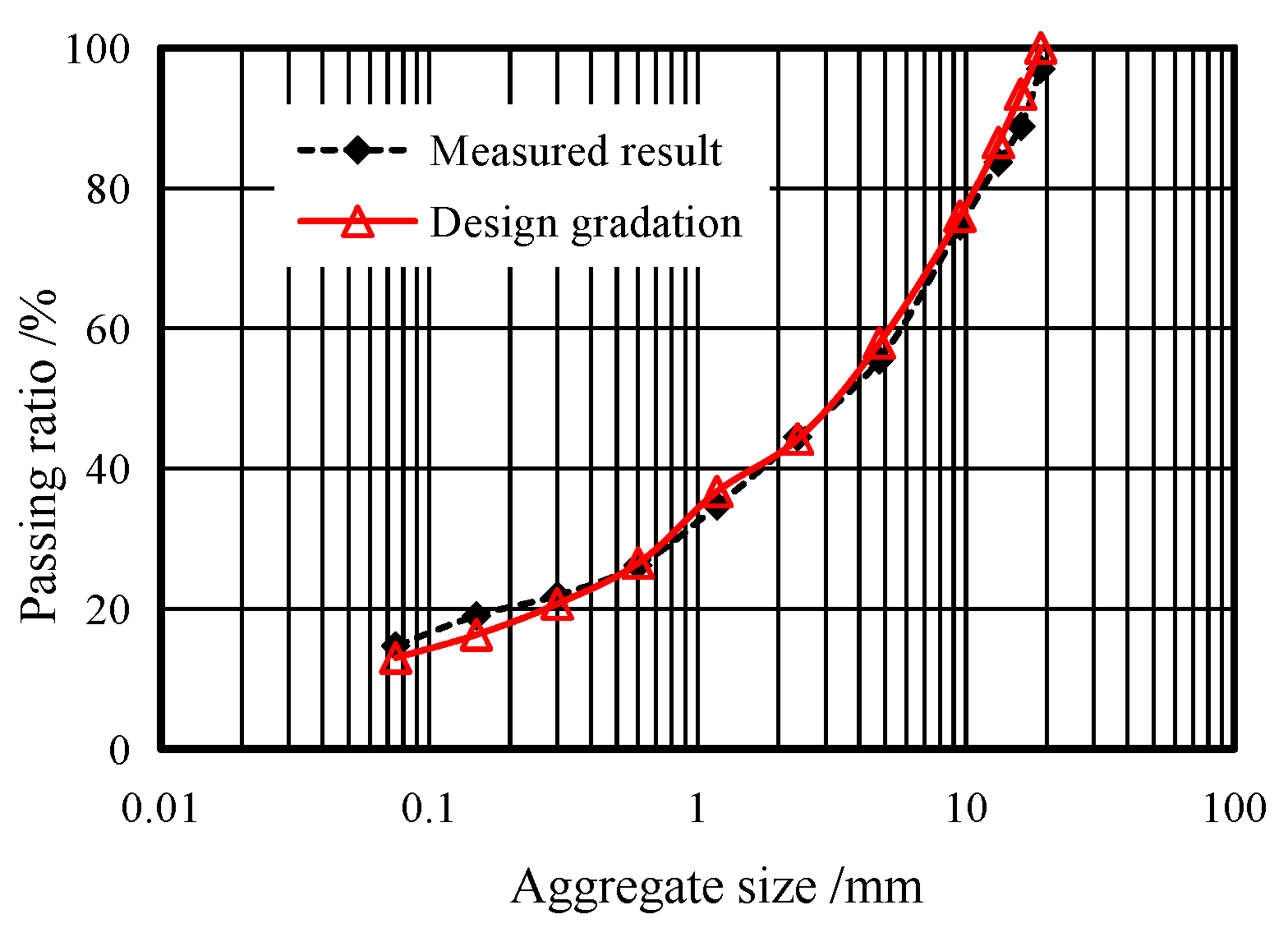

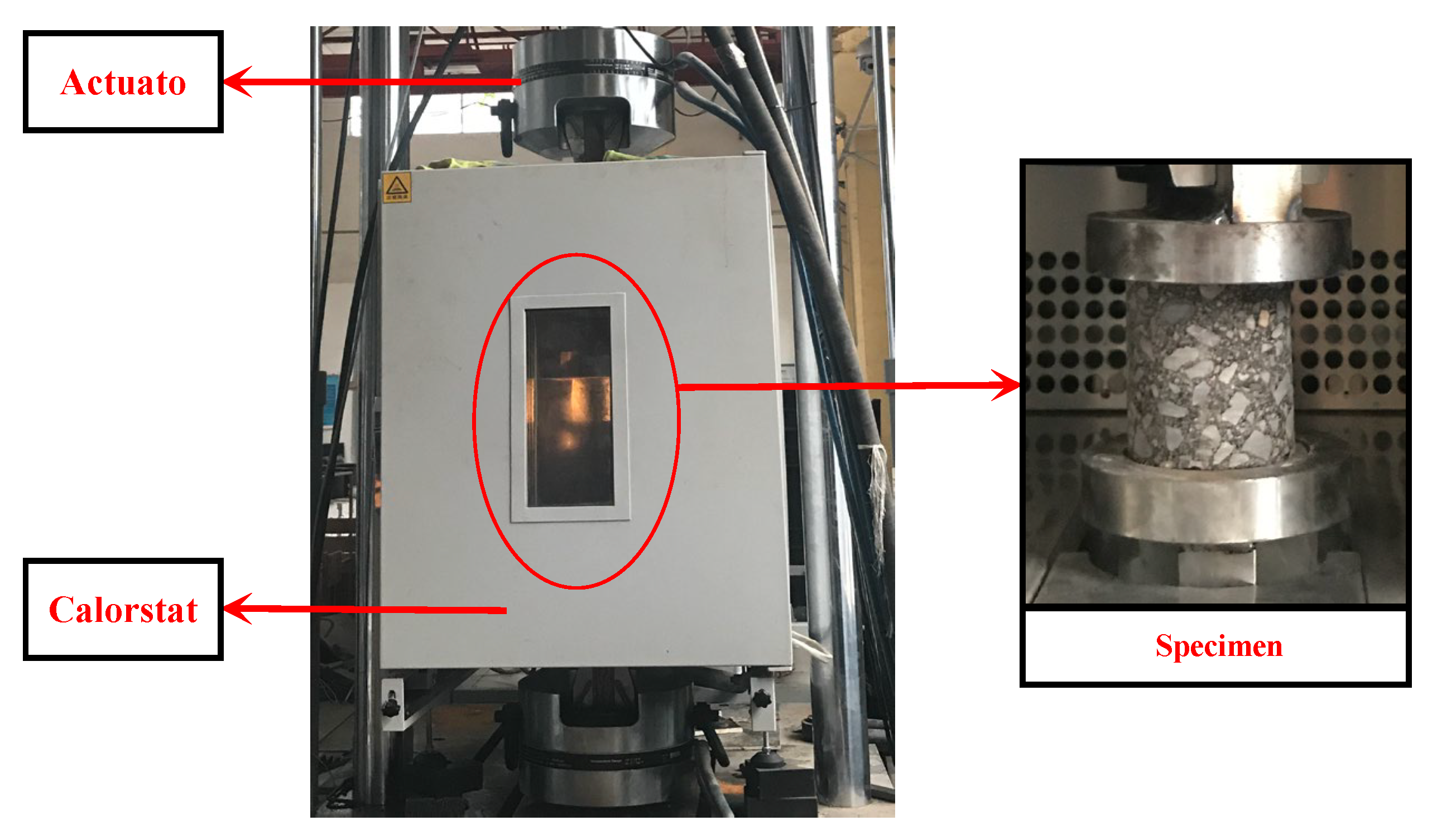
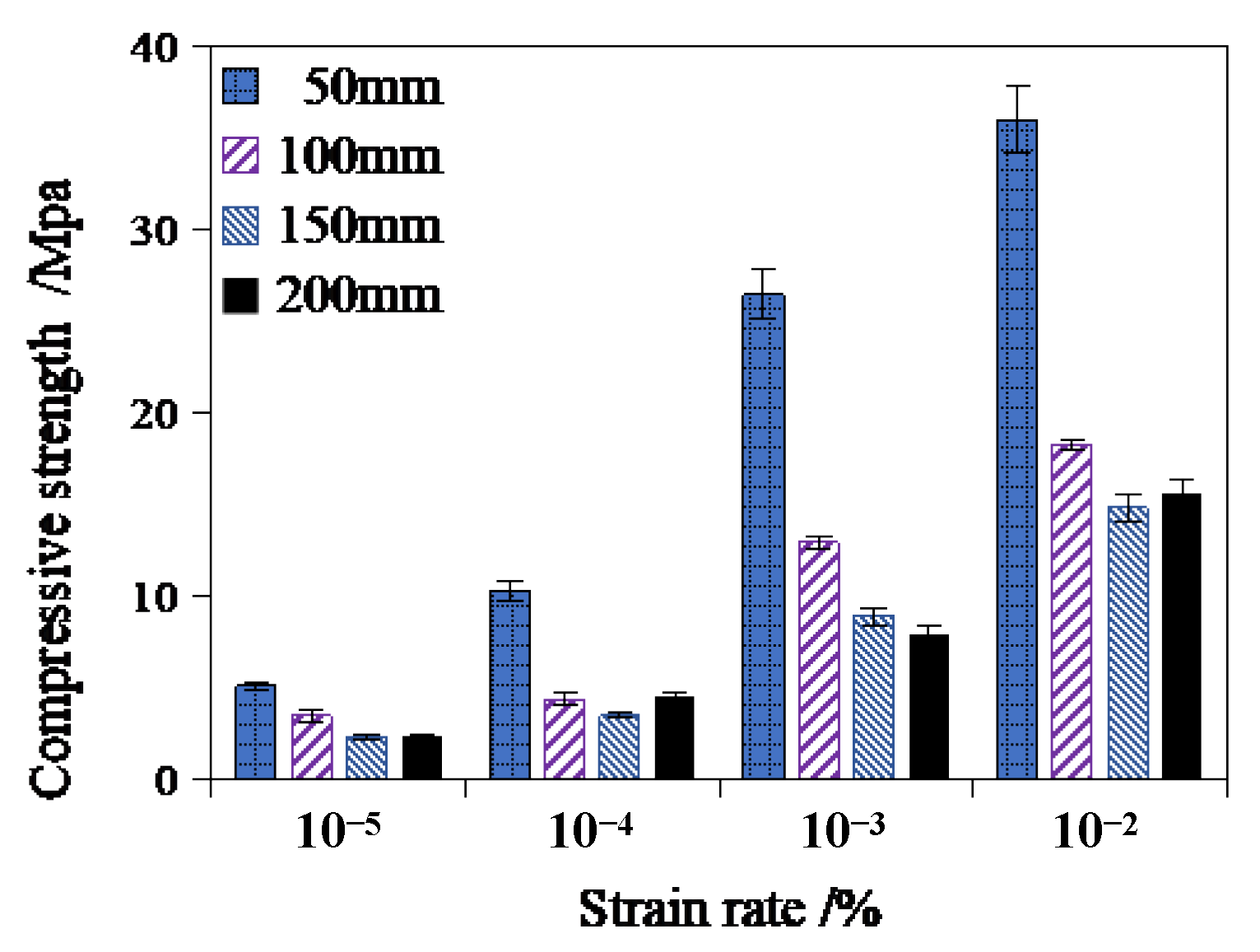
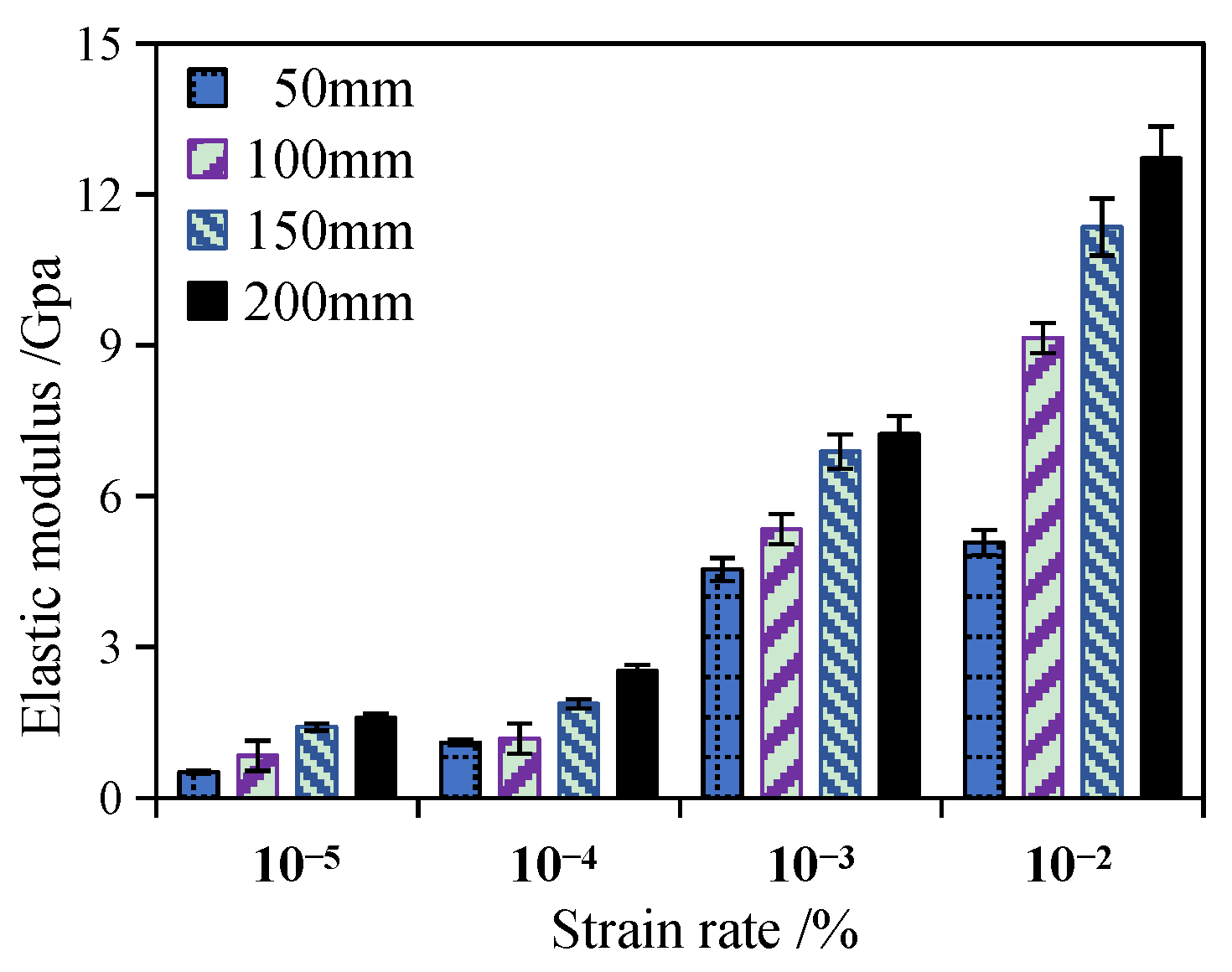

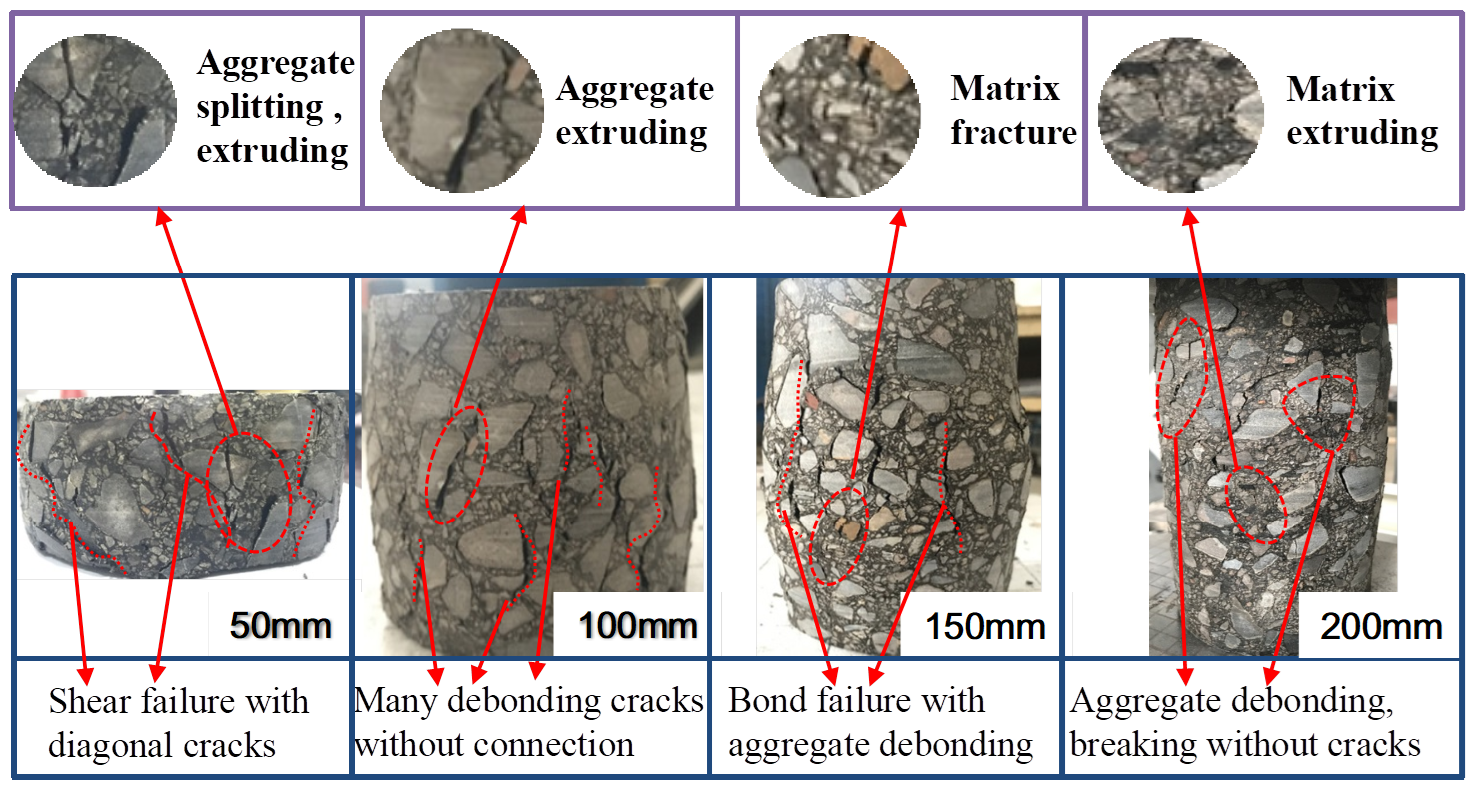
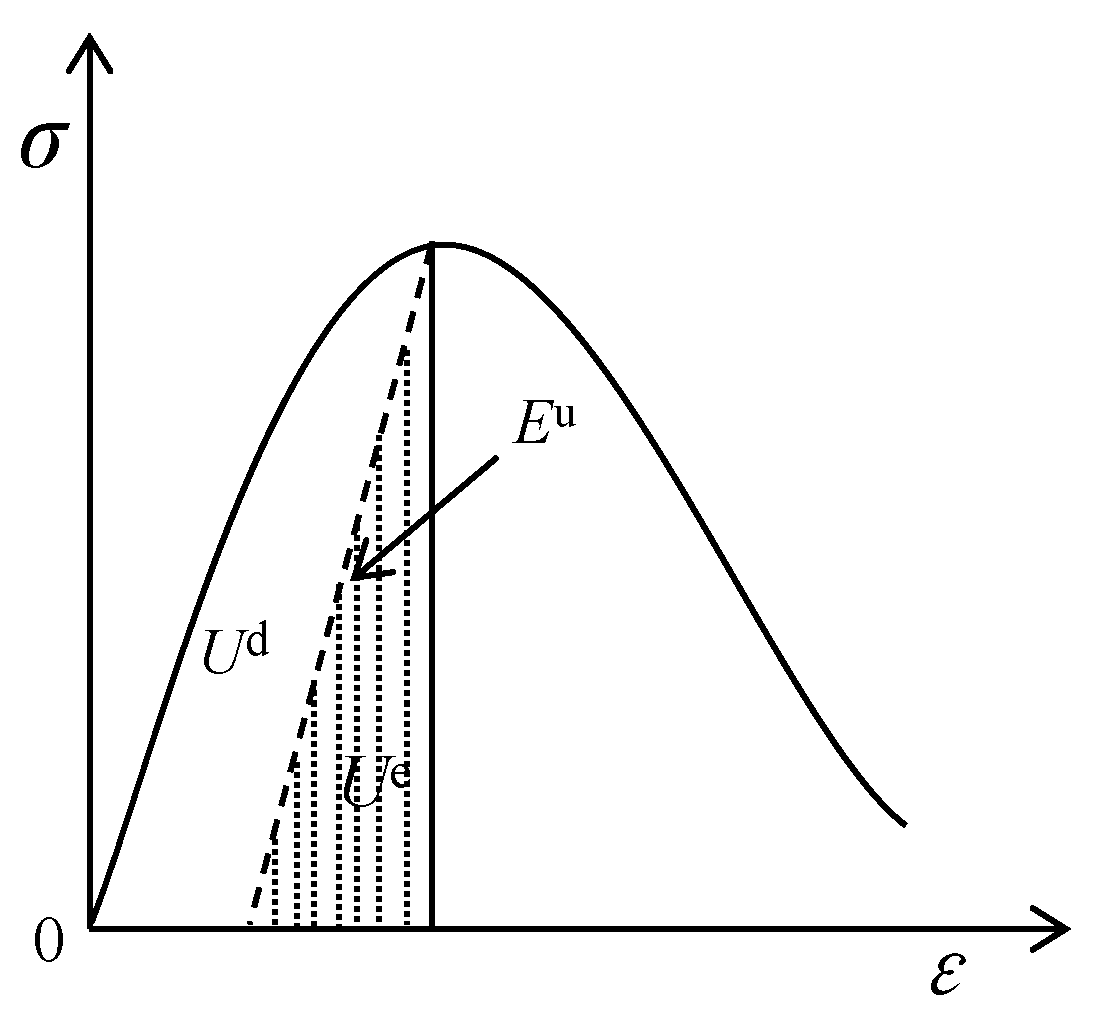
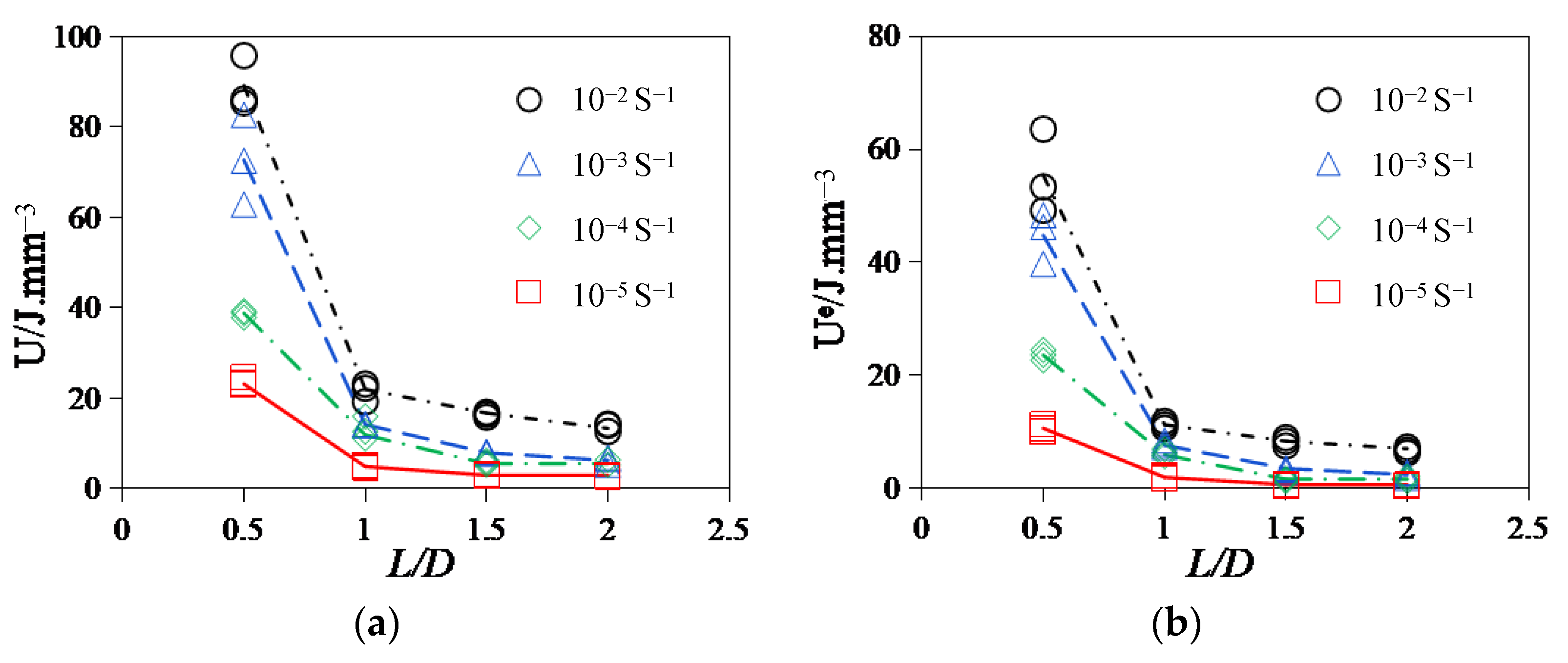
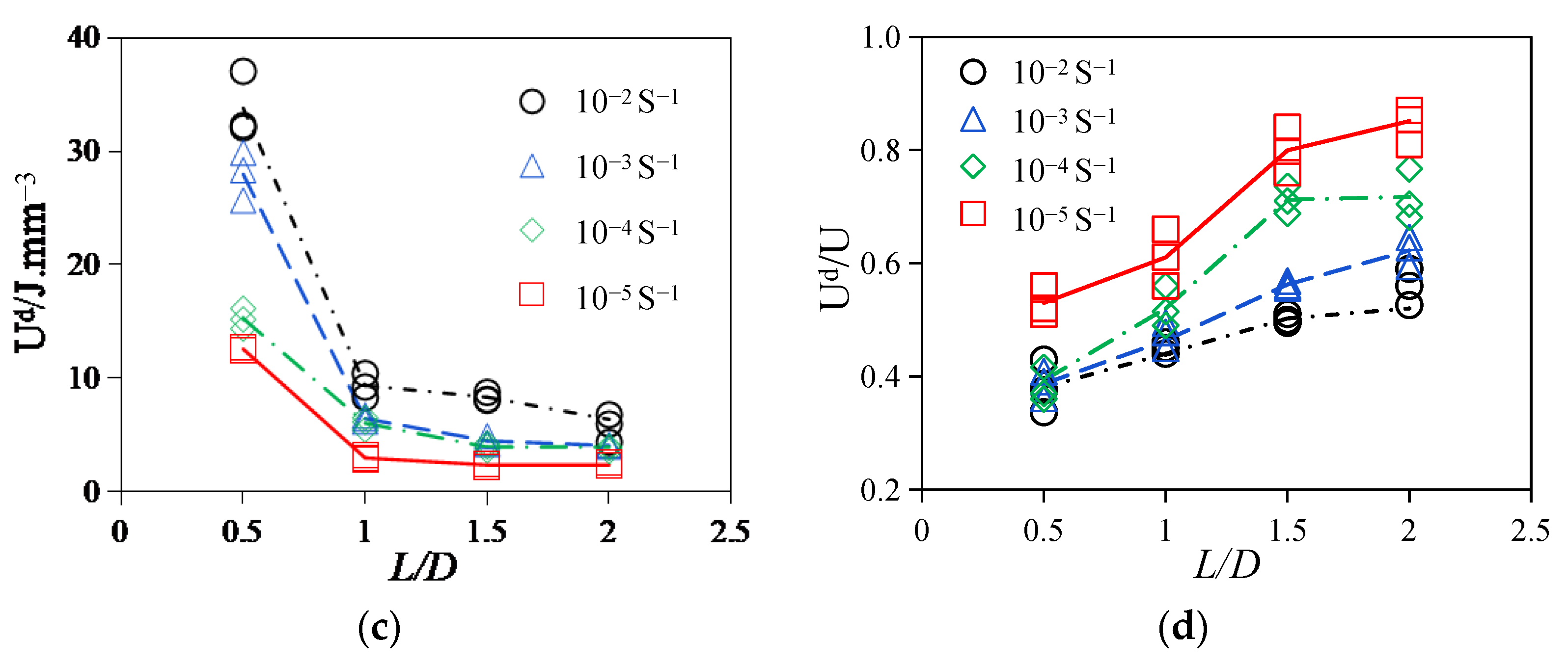
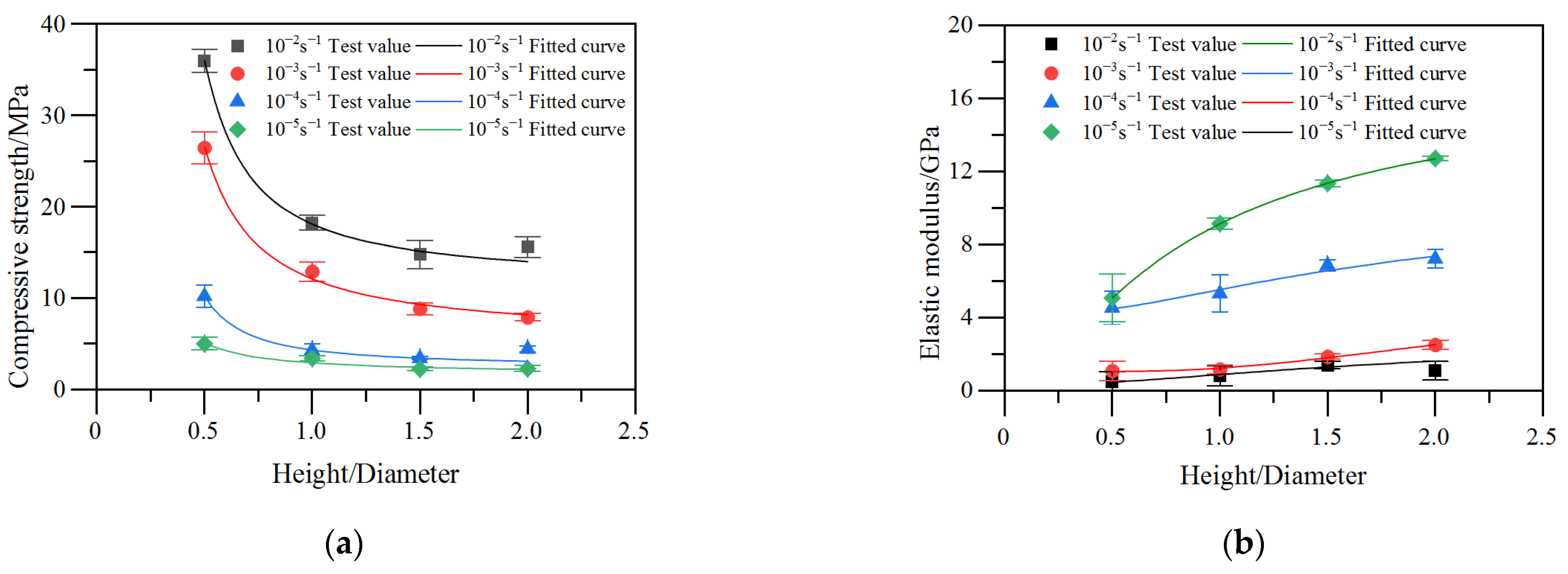

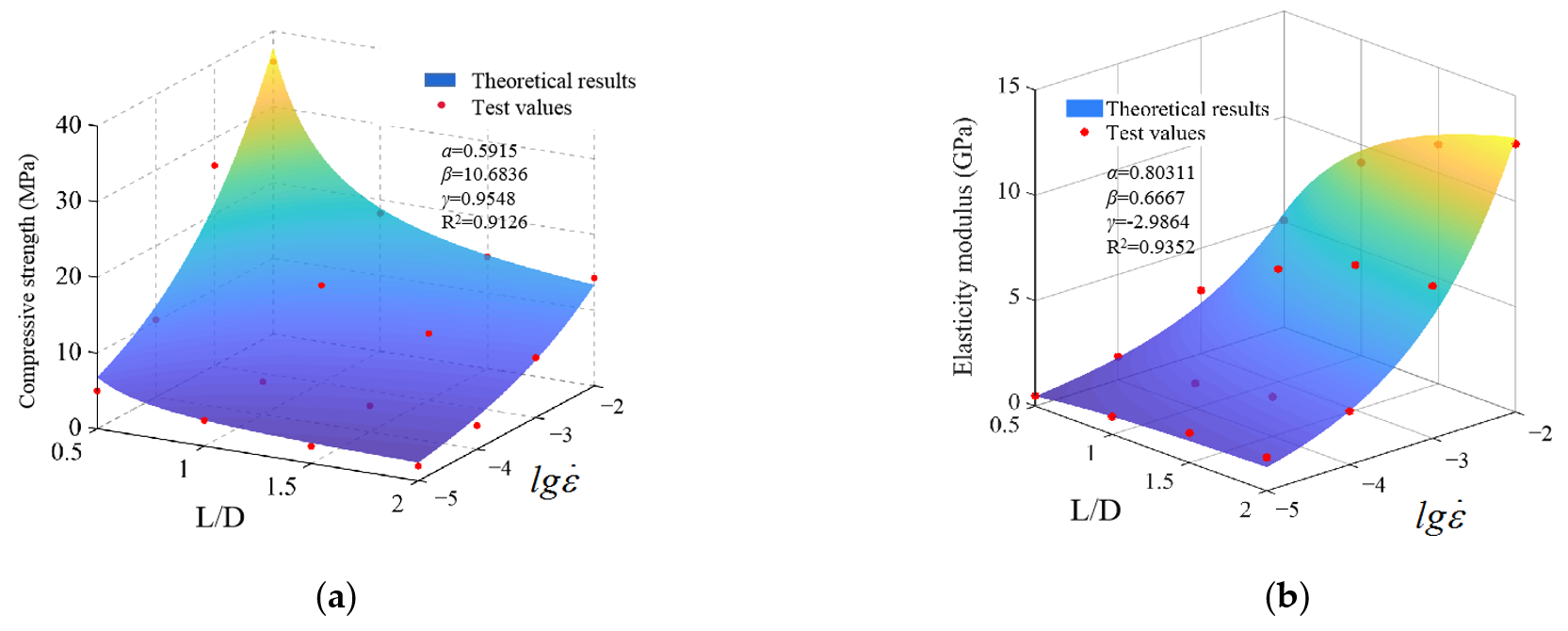
| Strain Rate () /s−1 | 10−5 | 10−4 | 10−3 | 10−2 | |
|---|---|---|---|---|---|
| Height/mm | |||||
| 50 | 5.01 | 10.22 | 26.44 | 35.98 | |
| 100 | 3.40 | 4.33 | 12.88 | 18.22 | |
| 150 | 2.25 | 3.43 | 8.83 | 14.76 | |
| 200 | 2.30 | 4.43 | 7.91 | 15.59 | |
| Strain Rate /s−1 | 10−5 | 10−4 | 10−3 | 10−2 | |
|---|---|---|---|---|---|
| Height/mm | |||||
| 50 | 0.51 | 1.10 | 4.54 | 5.08 | |
| 100 | 0.84 | 1.18 | 5.34 | 9.15 | |
| 150 | 1.41 | 1.87 | 6.88 | 11.35 | |
| 200 | 1.59 | 2.52 | 7.23 | 12.71 | |
| Strain Rate/s−1 | |||||
|---|---|---|---|---|---|
| 10−5 s−1 | 10−4 s−1 | 10−3 s−1 | 10−2 s−1 | ||
| Compressive strength | β1 | 10.6836 | 5.3997 | 2.3286 | 1.7391 |
| γ1 | 0.9548 | 0.8261 | 0.7876 | 0.6148 | |
| Elastic modulus | β2 | 0.6667 | 0.7931 | 0.8142 | 0.8720 |
| γ2 | −2.9864 | −2.8048 | −2.4125 | −2.4938 | |
| L/D | |||||
|---|---|---|---|---|---|
| 0.5 | 1 | 1.5 | 2 | ||
| Compressive strength | α1 | 0.6784 | 0.59145 | 0.63259 | 0.66595 |
| R2 | 0.91164 | 0.94579 | 0.98534 | 0.99181 | |
| Elastic modulus | α2 | 0.80165 | 0.80621 | 0.82631 | 0.74145 |
| R2 | 0.85927 | 0.95991 | 0.95144 | 0.85222 | |
Disclaimer/Publisher’s Note: The statements, opinions and data contained in all publications are solely those of the individual author(s) and contributor(s) and not of MDPI and/or the editor(s). MDPI and/or the editor(s) disclaim responsibility for any injury to people or property resulting from any ideas, methods, instructions or products referred to in the content. |
© 2024 by the authors. Licensee MDPI, Basel, Switzerland. This article is an open access article distributed under the terms and conditions of the Creative Commons Attribution (CC BY) license (https://creativecommons.org/licenses/by/4.0/).
Share and Cite
Meng, X.; Liu, Y.; Ning, Z.; Dong, J.; Liang, G. Experimental Investigation of the Size Effect on Roller-Compacted Hydraulic Asphalt Concrete under Different Strain Rates of Loading. Materials 2024, 17, 353. https://doi.org/10.3390/ma17020353
Meng X, Liu Y, Ning Z, Dong J, Liang G. Experimental Investigation of the Size Effect on Roller-Compacted Hydraulic Asphalt Concrete under Different Strain Rates of Loading. Materials. 2024; 17(2):353. https://doi.org/10.3390/ma17020353
Chicago/Turabian StyleMeng, Xiao, Yunhe Liu, Zhiyuan Ning, Jing Dong, and Gang Liang. 2024. "Experimental Investigation of the Size Effect on Roller-Compacted Hydraulic Asphalt Concrete under Different Strain Rates of Loading" Materials 17, no. 2: 353. https://doi.org/10.3390/ma17020353
APA StyleMeng, X., Liu, Y., Ning, Z., Dong, J., & Liang, G. (2024). Experimental Investigation of the Size Effect on Roller-Compacted Hydraulic Asphalt Concrete under Different Strain Rates of Loading. Materials, 17(2), 353. https://doi.org/10.3390/ma17020353









